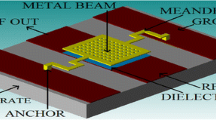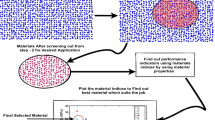Abstract
In this paper, the design of a low-k meander based MEMS shunt capacitive switch with perforated beam meander has been presented. A closed form analytical model to calculate the switching time of designed structure is proposed. The model is based on modified Mejis and Fokkema’s capacitance model and linearization of non-linear electrostatic force on the switch beam. The model is utilized in evaluating the switching time for uniform as well as non-uniform serpentine meander designs, considering different values of actuation voltage and a wide variation of switching parameters. This work takes into account the beam perforation, fringing field and stiffness effect simultaneously altogether. The results obtained for both the meander designs under every design specifications has been found out to be less than or approximately equal to 100 µs. These model based results are then compared with 3D FEM simulated values. Comparative Analysis indicated that the model results and simulation results are in close agreement with each other.









Similar content being viewed by others
References
Castañer LM, Senturia SD (1999) Speed-energy optimization of electrostatic actuators based on pull-in. J Microelectromech Syst 8(3):290–298
Cevher AK, Yildiz (2014) An inversely designed model for calculating pull-in limit and position of electrostatic fixed–fixed beam actuators. Res Artic Math Probl Eng (Hindawi Publishing Corporation) 2014:1–7
Chan EK, Kan EC, Dutton RW, Pinsky PM (1999). Nonlinear dynamic modeling of micromachined microwave switches. In: Proceedings of the IEEE MTT-S international microwave symposium, Denver, CO, pp 1511–151
Chen KYE, Daneshmand M, Mansour Raafat R, Ramer R (2008) RF-MEMS switches with new beam geometries: improvement of yield and lowering of actuation voltage. In: Proceedings of SPIE, vol 6800
Chowdhury S, Ahmadi M, Miller WC (2005) A Comparison of pull-in voltage calculation methods for MEMS based electrostatic actuator design. In: Proceedings of the 1st international conference on sensing technology, Palmerston North, New Zealand
Chowdhury S, Ahmadi M, Miller WC (2006) Pull-in voltage study of electrostatically actuated fixed–fixed beams using a VLSI on-chip interconnect capacitance model. J Microelectromech Syst 15(3):639–651
Dennis JO, Ahmed AY, Khir MHMd, Rabih A (2015) Modelling and simulation of the effect of air damping on the frequency and quality factor of a CMOS-MEMS resonator. Appl Math Inf Sci 9(2):729–737
Fang X, Myung N, Nobe K et al (2001) Modelling the effect of etch holes on ferromagnetic MEMS. In: Proceedings of the 8th joint magnetism and magnetic materials—international magnetic conference—(MMM-Intermag), San Antonio, TX, pp 2637–2639
Fang DM, Li XH, Yuan QA et al (2010) Effect of etch holes on the capacitance and pull-in voltage in MEMS tunable capacitors. Int J Electron 97(12):1439–1448
Fedder GK (1994) Simulation of microelectromechanical systems. Ph.D. dissertation, Department of Electrical Engineering and Computer Science, University of California at Berkeley, Berkeley, CA
Gabbay LD, Mehner JE, Senturia SD (2000) Computer-aided generation of nonlinear reduced-order dynamic macromodels—I: non-stress stiffened case. J Microelectromech Syst 9(2):262–269
Grewal BS (2014) Higher engineering mathematics, 43rd edn. Khanna Publishers, India
Guha K, Kumar M, Agarwal S, Baishya S (2015) A modified capacitance model for RF MEMS shunt switch incorporating fringing field effect of perforated beam. Solid state electronics. Elsevier, Amsterdam
Guha K, Laskar NM, Gogoi HJ, Borah AK, Baishnab KL, Baishya S (2017) Novel analytical model for optimizing the pull-in voltage in a flexure MEMS switch incorporating beam perforation effect. Solid State Electron Elsevier 137:85–94
Guo FM, Zhiqiang Z, Long YF, Lu W (2003) Study on low voltage actuated MEMS RF capacitive switches. Sens Actuators A Phys 108:128–133
Hung ES, Senturia SD (1999) Generating efficient dynamic models for microelectromechanical systems from a few finite-element simulation runs. J Microelectromech Syst 8(3):280–289
Iannacci J (2013) Practical Guide to RF-MEMS, 1st edn. Wiley-VCH, Weinheim
Kaajakari V (2009) Closed form expressions for RF MEMS switch actuation and release time. Electron Lett IET 43(3):149–150
Kundu A, Sethi S, Mondal NC, Gupta B, Lahiri SK, Saha H (2010) Analysis and optimization of two movable plates RF MEMS switch for simultaneous improvement in actuation voltage and switching time. Microelectron J 41(5):257–265
Lahiri SK, Saha H, Kundu A (2009) RF MEMS SWITCH: an overview at-a-glance. In: 4th international conference on computers and devices for communication, Kolkata
Liu AQ, Yu BM, Karim MF, Tang M (2007) RF MEMS switches and integrated switching circuits. J Semicond Technol Sci 7:166–176
Mafinejad Y, Zarghami M, Kouzani Abbas Z, Mafinezhad K (2013) Design and simulation of a high isolation RF MEMS shunt capacitive switch for C-K band. IEICE Electron Express 10(24):1–8
Newman H.S. (2002) RF MEMS switches and applications (INVITED). In: Proceedings of the 2002 40th annual IEEE international reliability physics symposium, Dallas, TX, pp 111–115
Paldas A, Gupta N (2013) Material selection and parameter characterization for RF MEMS switches. Int J Mech Prod Eng 1(3):7–12
Pelesko JA, Bernstein DN (2003) Modeling MEMS and NEMS. CRC Press, Boca Raton
Rabinovich VL, Gupta RK, Senturia SD (1997) The effect of release-etch holes on the electromechanical behaviour of MEMS structures. In: Proceedings of the IEEE international conference on solid-state sensors and actuators, Chicago, pp 1125–1128
Ramakrishnan KA, Srinivasan HT (2012) Closed form models for pull-in voltage of electrostatically actuated cantilever beams and comparative analysis of cantilevers and microgripper. J Electr Eng 63(4):242–248
Rebeiz GM (2003) RF MEMS switches: status of the technology. TRANSDUCERS ’03. In: 12th international conference on solid-state sensors, actuators and microsystems. Digest of technical papers (Cat. No.03TH8664), vol 2, pp 1726–1729
Rebeiz GM (2003b) RF MEMS theory, design and technology. Wiley, New Jersey
Rocha LA, Cretu E, Wolffenbuttel RF (2004) Analytical model for the pull-in time of low-Q MEMS devices Delft University of Technology, Faculty EEMCS Meta-stable Region, vol 2, pp 271–274
Sani EA, Afrang S (2006) A low voltage MEMS structure for RF capacitive switches. Prog Electromagn Res 65:157–167
Senturia SD (2001) Microsystem design. Kluwer, Boston
Sharma AK, Gupta N (2014) Investigation of actuation voltage for non-uniform serpentine flexure design of RF-MEMS switch. Springer Microsyst Technol 20(3):413–418
Shekhar S, Vinoy KJ, Ananthasuresh GK (2011) Switching and release time analysis of electrostatically actuated capacitive RF MEMS switches. Sens Transducers 130(7):77–90
Shen D, Park J, Ajitsaria J, Choe S, Wikle HC, Kim D (2008) The design, fabrication and evaluation of a MEMS PZT cantilever with an integrated Si proof mass for vibration energy harvesting. J Micromech Microeng 18(5):055017
Taye J, Guha K, Baishya S (2013) Design and analysis of RF MEMS shunt capacitive switch for low actuation voltage and high capacitance ratio. Physics of semiconductor devices. Springer, Cham
Van de Meijs N, Fokkema JT (1984) VLSI circuit reconstruction from mask topology. Integr VLSI J 2(2):85–119
Younis MI, Abdel-Rahman EM, Nayfeh A (2003) A reduced-order model for electrically actuated microbeam-based MEMS. J Microelectromech Syst 12(5):672–680
Acknowledgements
The authors acknowledge the National MEMS Design Centre of Department of Electronics and Communication Engineering at National Institute of Technology Silchar, India for providing all necessary facilities to carry out the research work.
Author information
Authors and Affiliations
Corresponding author
Rights and permissions
About this article
Cite this article
Guha, K., Laskar, N.M., Gogoi, H.J. et al. A new analytical model for switching time of a perforated MEMS switch. Microsyst Technol 26, 3143–3152 (2020). https://doi.org/10.1007/s00542-018-3803-8
Received:
Accepted:
Published:
Issue Date:
DOI: https://doi.org/10.1007/s00542-018-3803-8




